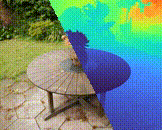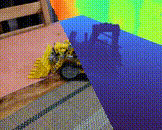Tetra-NeRF#
Tetra-NeRF: Representing Neural Radiance Fields Using Tetrahedra
SfM input pointcloud is triangulated and resulting tetrahedra is used as the radiance field representation
Installation#
First, make sure to install the following:
CUDA (>=11.3)
PyTorch (>=1.12.1)
Nerfstudio (>=0.2.0)
OptiX (>=7.2, preferably 7.6)
CGAL
CMake (>=3.22.1)
Follow the installation section in the tetra-nerf repository
Finally, you can install Tetra-NeRF by running:
pip install git+https://github.com/jkulhanek/tetra-nerf
Running Tetra-NeRF on custom data#
Details for running Tetra-NeRF can be found here.
python -m tetranerf.scripts.process_images --path <data folder>
python -m tetranerf.scripts.triangulate --pointcloud <data folder>/sparse.ply --output <data folder>/sparse.th
ns-train tetra-nerf --pipeline.model.tetrahedra-path <data folder>/sparse.th minimal-parser --data <data folder>
Three following variants of Tetra-NeRF are provided:
Method |
Description |
Memory |
Quality |
|---|---|---|---|
|
Official implementation from the paper |
~18GB* |
Good |
|
Different sampler - faster and better |
~16GB* |
Best |
*Depends on the size of the input pointcloud, estimate is given for a larger scene (1M points)
Method#
The input to Tetra-NeRF is a point cloud which is triangulated to get a set of tetrahedra used to represent the radiance field. Rays are sampled, and the field is queried. The barycentric interpolation is used to interpolate tetrahedra vertices, and the resulting features are passed to a shallow MLP to get the density and colours for volumetric rendering.
Existing checkpoints and predictions#
For an easier comparisons with Tetra-NeRF, published checkpoints and predictions can be used:



